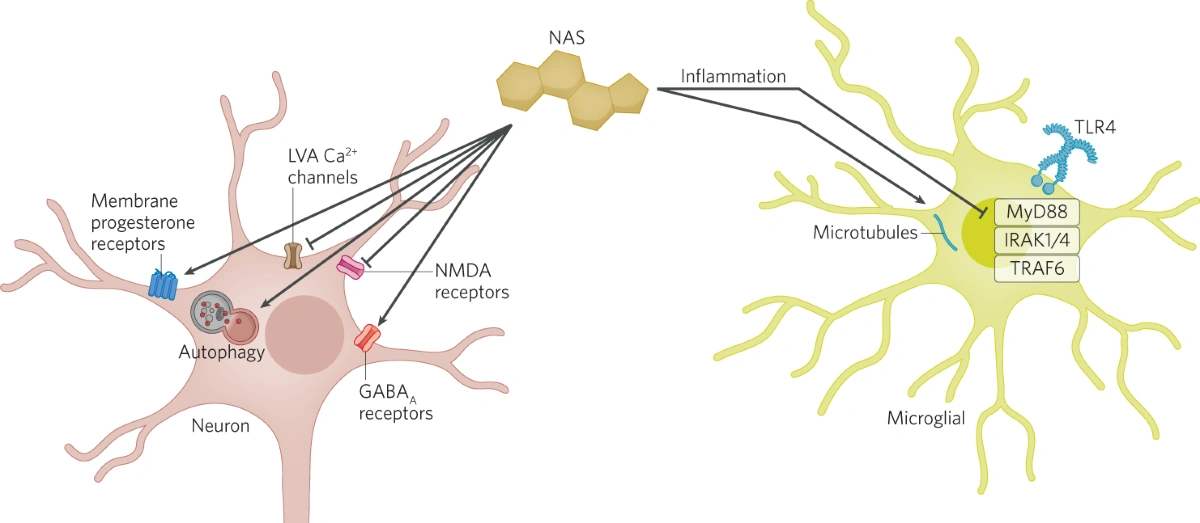Quick Overview
If you’ve ever felt the crushing weight of depression or anxiety and wished a medication could kick in as quickly as a cup of coffee, you’re not alone. Neurosteroid drugs are exactly that kind of breakthrough – they act within minutes to calm the brain’s over‑excited circuits. Think of them as the fast‑acting friends who show up early to a party, while traditional antidepressants like SSRIs tend to arrive fashionably late, sometimes after a few weeks.
In a nutshell, neurosteroid drugs are synthetic or naturally derived steroids that modulate the GABA system – the brain’s primary “brake” neurotransmitter. By enhancing GABA’s inhibitory power, these compounds can lift mood, ease anxiety, and even stop seizures, all without the slow‑rolling buildup you see with many conventional meds.
GABA Connection
The GABA system is the brain’s quiet‑time supervisor. When GABA binds to its receptor (the GABAA channel), it opens a tiny door that lets chloride ions flow in, making neurons less likely to fire. Neurosteroid drugs act as positive allosteric modulators – they don’t sit in the main “keyhole” of the receptor but bind to a side pocket, turning up the volume on GABA’s calming effect.
Positive Allosteric Modulation
Imagine GABA as a gentle wind blowing through a field. A neurosteroid drug is like a wind‑turbine that catches that breeze and amplifies it, so the field (your brain) doesn’t get too windy (over‑excited). The result? A smoother, more stable emotional state.
Subunit Selectivity
GABAA receptors are made of different protein subunits (α, β, γ, δ, etc.). Some neurosteroids prefer receptors that contain the δ subunit, which are abundant in brain regions that regulate mood and stress. This selectivity helps explain why drugs like brexanolone and zuranolone work so well for postpartum depression while causing fewer “sedative” side effects than classic benzodiazepines.
Beyond GABA
Researchers are also peeking at non‑GABA targets – NMDA, sigma‑1, and even inflammatory pathways – that might give neurosteroids extra therapeutic tricks. A recent review suggests these pathways could help with PTSD, Alzheimer’s, and chronic pain, but that’s a story for another day.
Approved Options
Below is a quick snapshot of the neurosteroid drugs that have made it through the regulatory gauntlet (or are almost there). Feel free to bookmark this table if you’re discussing options with a clinician.
| Drug | Brand | Route | FDA Status | Primary Indication |
|---|---|---|---|---|
| Brexanolide (allopregnanolone) | Brexanol | IV (48‑hour infusion) | Approved 2019 | Postpartum depression |
| Zuranolone | SAGE‑217 | Oral | Approved 2023 | Postpartum & Major depressive disorder |
| Ganaxolone | Ztalmy | Oral | Approved 2024 (Epilepsy) | Epilepsy, Generalized anxiety |
| Sepranolone | — | Oral | Phase III | Post‑partum depression (investigational) |
| LYT‑300 (Brexanolide caprilcerbate) | — | Oral (pro‑drug) | Investigational | Anxiety, Depression |
Clinical Uses
Post‑natal & Postpartum Depression
Let’s be honest: talking about postpartum mood struggles can feel like whispering in a crowded room. Yet, the data are crystal clear – neurosteroid drugs are a game‑changer for postnatal depression treatment. In a landmark trial, a single 48‑hour IV infusion of brexanolone lifted depressive scores in 70% of participants within just a few days. That’s the kind of rapid relief you’d expect from a strong cup of espresso, not a slow‑drip brew.
Take “Sarah,” a 31‑year‑old new mom who tried two different SSRIs with no improvement. After a week of brexanolone, she reported feeling “like myself again” and could finally enjoy her baby’s smile. Stories like Sarah’s underscore why clinicians are eager to add neurosteroids to their postpartum depression remedies toolkit.
Major Depressive Disorder (MDD)
Beyond the postpartum setting, zuranolone is making waves for broader MDD. Phase III trials showed that a 14‑day oral course of zuranolone produced a statistically significant drop in Hamilton Depression Rating Scale scores compared to placebo, and the effect lasted for weeks after the pill was stopped. While it’s not yet a first‑line therapy, many psychiatrists see it as a valuable “bridge” for patients who need quicker relief before classic antidepressants for depression kick in.
Anxiety & Stress‑Related Conditions
Because neurosteroids dial up GABA, they naturally have anxiolytic (anxiety‑reducing) properties. Small open‑label studies with ganaxolone have reported reduced scores on the Generalized Anxiety Disorder‑7 scale without the heavy sedation you sometimes see with benzodiazepines. If you’re battling chronic worry, ask your provider whether a neurosteroid trial fits your situation.
Neurological Disorders
Ganaxolone earned FDA approval for treating certain seizure types, and its calming GABA boost makes it a candidate for PTSD and even early‑stage Alzheimer’s research. Though still experimental, the idea of a single medication that could address mood, anxiety, and seizures is undeniably exciting.
Benefits & Risks
Therapeutic Advantages
- Fast onset: Relief can appear within hours to days.
- Different mechanism: Works when serotonin‑based meds fail.
- Oral options: Zuranolone and ganaxolone make treatment convenient.
- Targeted action: Subunit selectivity may translate to fewer side effects.
Potential Side Effects
Every medication has a flip side. Common complaints include mild dizziness, transient sedation, and occasional headache. The IV brexanolone infusion can cause nausea or a brief rise in blood pressure – nurses monitor you closely, so you’re in safe hands.
Monitoring & Contra‑Indications
Before starting, doctors usually order liver function tests and check for severe hepatic disease, since the liver processes most neurosteroids. Pregnancy is a special case: while brexanolone is approved for postpartum use, it’s not recommended during pregnancy itself.
Quick‑Check List for Patients
- Confirm liver health (ALT, AST, bilirubin).
- Discuss any current meds – especially benzodiazepines or barbiturates.
- Ask about insurance coverage; many plans treat these as specialty drugs.
- Plan for monitoring visits – first follow‑up usually within a week.
Compared To Antidepressants
Traditional antidepressants (SSRIs, SNRIs, tricyclics) mostly tweak serotonin or norepinephrine and need 4–6 weeks to show effect. Neurosteroids, by contrast, amplify GABA right away. However, the long‑term data for relapse prevention are still emerging. Some clinicians combine a short neurosteroid course with an SSRI to keep the mood boost going once the neurosteroid is tapered off.
In a head‑to‑head review, patients receiving a neurosteroid reported higher satisfaction scores than those on SSRIs, mainly because “I felt better faster.” That said, cost can be higher, and IV delivery (for brexanolone) can feel intimidating. The best choice depends on individual history, severity, and personal preference.
Practical Tips
Insurance & Cost
Neurosteroid drugs are often classified as “specialty” medications, so co‑pays can be steep. Many pharmaceutical companies offer patient‑assistance programs, and your healthcare provider may be able to submit a prior‑authorization request that highlights the rapid‑response benefit.
Administration Logistics
Brexanolone requires a 48‑hour stay in an infusion center – think of it as a short “medical vacation” where nurses monitor vitals, and you can bring a pillow, a good book, or even a playlist of soothing music. Oral drugs like zuranolone and ganaxolone are as easy as taking a daily vitamin, though they still need a prescription and periodic lab checks.
FAQs You Might Be Wondering
- Can I breast‑feed while on a neurosteroid? Yes, for brexanolone and zuranolone, the FDA label indicates it’s safe after delivery, but always confirm with your OB‑GYN.
- What if I miss a dose? For oral agents, take it as soon as you remember unless it’s within a few hours of the next scheduled dose – then skip and resume the regular schedule.
- Will I become dependent? Neurosteroids have a low risk of dependence compared with benzodiazepines because they act at a different site on the GABAA receptor.
Future Outlook
The neurosteroid field is buzzing with innovation. Scientists are designing enantiomer‑pure versions that may be even more selective, and some groups are exploring “pro‑drug” forms that bypass the liver entirely, promising even fewer side effects.
Imagine a future where a simple oral pill not only lifts depression but also protects neurons from age‑related damage – that’s the vision driving current trials on sigma‑1 and inflammatory pathways.
For now, the take‑home message is clear: neurosteroid drugs offer rapid, targeted relief for a range of mood and neurological conditions, and they’re expanding our therapeutic toolbox in exciting ways.
Conclusion
Whether you’re a new parent wrestling with postpartum blues, someone searching for a faster‑acting antidepressant, or a clinician looking for novel seizure control, neurosteroid drugs are worth a close look. They work by tuning the brain’s GABA system, delivering relief often within days, and they bring a fresh mechanism that can complement or even replace traditional antidepressants for depression. Like any medication, they come with benefits and risks, so a candid conversation with your healthcare provider is key.
What do you think? Could a neurosteroid be the missing piece in your mental‑health puzzle? If you have questions or want to explore whether one of these drugs might fit your story, don’t hesitate to reach out to a trusted professional. Here’s to finding the relief you deserve, faster and smarter.


















Leave a Reply
You must be logged in to post a comment.